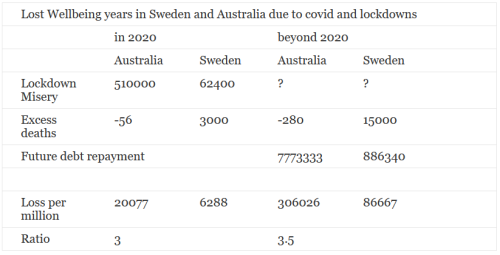Compared to the trends on January 2020, has Australia or Sweden lost more wellbeing in 2020? And which has seen the greater damage to expected future wellbeing years for after 2020? The Table below summarizes the answers to this.
For the first calculation, let us only count the main elements going into the wellbeing of these two countries in 2020: the experienced wellbeing of the population in 2020 and the excess deaths in 2020. Lots of the other things we normally look at in these covid-calculations, such as changes to GDP, will show up in the anticipated effects for after 2020.

Advertisement
First, what was the wellbeing drop in Australia? Well, an ANU-sponsored longitudinal panel found a drop from 6.9 to 6.5 in their life-satisfaction poll from January to April, a huge decline that is similar to the drop in the UK. This panel is based on over 3,000 individuals, which is why this drop is strongly statistically significant.

What about the rest of 2020 in Australia though? The same ANU team, headed by Professor Biddle said at the end of 2020 about the lockdowns in Australia that they were "a massive hit to happiness, experienced by Australians from all walks of life". They document the increased inequality and how things are particularly bad among the young and the vulnerable in general. Their key graph for the whole of 2020 is above.
This graph aggregates the changes in Australia in the various states, though the ANU team found one can clearly see that life satisfaction plummets in every state during a lockdown but recovers very quickly afterwards, so the top graph is essentially directly related to the average severity of lockdowns in Australia. Now, in terms of actual numbers, we should note that relative to December 2019-Jan 2020, (6.95 on average), Australia from March onwards had an average of around 6.8: the country was right back at the end of 2020 when there almost no lockdowns anywhere, but experiencing various degrees of suffering at other periods.
Now, how bad is an average loss of 0.15 for 9 months, ie a loss of 0.1 for the whole of 2020? A loss of 0.1 means a loss for the 25.4 million Australians of 2.54 million units of wellbeing (called WELLBYs). Since a wellbeing level of 2 is when individuals are, roughly speaking, indifferent between continued living or not, and a regular wellbeing year is spent at level 7, a regular year of life in Australia is worth 5 units of wellbeing. So the 2.54 million lost units are equivalent to 510,000 lost years of wellbeing in Australia in 2020.
In that 510,000 wellbeing years is all the misery caused by lockdowns and social distancing: all the cancelled weddings, all the additional cases of depression, all the extra anxiety, all the worry about unemployment, all the loneliness, all the abused women who could not escape, all the people who were not helped at hospitals, all the people whose IVF treatments were cancelled, etc. These numbers are also born out by other Australian surveys, such as on the strongly worsened mental health situation of Australia's youth due to barred access to school, evidenced in official reports. The fact that the media does not talk about these lockdowns-victims much doesn't mean this suffering does not exist.
Advertisement
One can note, btw, that the data just released by the World Happiness Report 2021 fits in perfectly with this picture in that the drop reported there for Australia since 2019 of about 0.1 refers to data gathered in February to mid-March 2020, so largely before the drop but just nipping its first beginnings, hence the drop you expect you see for that period.
And wellbeing in Sweden? Unfortunately for Sweden, there is no neat large panel gathered during the whole year like there is for Australia to base the numbers on, but we do have some comparable data. What we know for Sweden is that, unlike in strong lockdown-countries like the UK or Victoria in Australia, there was no drop in the main wellbeing indicator (life-satisfaction) in the first weeks of the panic in Sweden: Kivi et al. (2020) found among the group one expects to see a drop (the 65-75 year olds) no change in their life satisfaction in early April relative to the previous year, just as, by the way, found in places like the Netherlands which in that period had very light lockdowns.
For the rest of the year, the data for Sweden is patchy. An imperial college panel covering the period after the initial lockdowns(so not the early change) found no significant drop in life satisfaction over time in Sweden for the rest of 2020, but that is essentially because that panel is extremely small (50-100 observations per two-week period). Yet, if we aggregate that data over three month periods, we see that there was a drop in the last 6 months of 2020 relative to the April-June period of 2020. Not a significant drop, but the drop was concentrated in the last 3 months which was when the Swedish government was over-riding its health authority with more restrictions, so exactly the period you do expect to see a drop. So on the balance of probabilities, Sweden probably did have a slight drop in 2020, concentrated in the last 3 months, amounting to a drop over the whole year of 0.03 (this is very close btw, to the insignificant small drop found for the 2020 Gallup data for Sweden underlying the World Happiness Report).